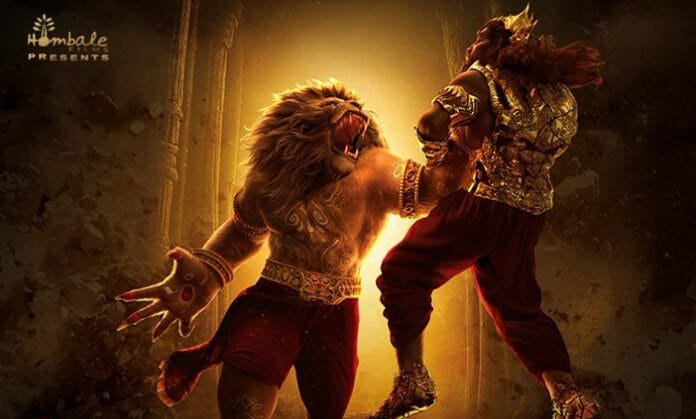Mahavatar Narsimha X Review: Devotion, Drama, and Divine Justice in an Animated Spectacle
On July 25, the silver screen witnessed the arrival of a cinematic miracle — Mahavatar Narsimha, a bold and emotionally charged animated retelling of one of the most iconic avatars of Lord Vishnu. Directed by Ashwin Kumar, this film breathes digital life into the ancient tale of Prahlad and Hiranyakashyap, blending rich animation with mythological depth. Viewer reactions on X (formerly Twitter) have erupted in waves of emotion, with many calling it a spiritual antidote to the chaos of modern storytelling — the “anti-virus of Saiyaara.”
A Divine Entry: Mahavatar Narsimha Hits Theaters
The release of Mahavatar Narsimha marked a significant milestone in Indian animated cinema, showcasing the potential of mythological storytelling beyond conventional formats. With its grand debut in theaters across India, audiences were introduced to a powerful spiritual journey. The story, deeply rooted in the Vishnu Purana, presents the eternal battle between good and evil, faith and tyranny, through the lens of Prahlad’s unwavering devotion and the terrifyingly majestic avatar of Narasimha.
The emotional intensity of this animated spectacle has stirred hearts nationwide, with social media flooded by reactions praising the film’s background score, emotional impact, and devotional resonance.
Emotions Run High on Social Media
Audiences took to X to express their feelings after watching the film. One user wrote, “I couldn’t hold back my tears. This is not just a film — it’s an experience.” Another remarked, “Background music gave me goosebumps. Narasimha’s roar still echoes in my mind.” A third simply said, “Blockbuster. Devotion meets power.“
Reactions continue pouring in, with viewers hailing it as a must-watch spiritual animation that deserves a big-screen experience. From the divine descent of Narasimha to the climactic confrontation, the film has been described as “a wave of emotion crashing into the soul.”
Plot Overview: A Timeless Tale Reimagined
The film faithfully adapts the Vishnu Purana’s story of Hiranyakashyap, a powerful asura king who seeks to destroy faith in Lord Vishnu, and his son Prahlad, whose deep devotion ignites the wrath of his father. As Hiranyakashyap grows increasingly tyrannical, threatening his own son’s life, the divine intervenes in the form of Narasimha — the half-man, half-lion avatar of Vishnu.
The emotional climax unfolds as Narasimha emerges from a pillar, manifesting at twilight, neither man nor beast, neither indoors nor outdoors — a flawless fulfillment of Brahma’s boon to Hiranyakashyap. What follows is a breathtaking sequence of divine justice, animated with raw power, vibrant symbolism, and a soul-stirring score.
Animation That Breathes Life Into Scriptures
One of the most applauded aspects of Mahavatar Narsimha is its stunning animation style, which manages to feel both modern and rooted in tradition. The colors are vivid yet spiritually soft, allowing the visuals to complement the mood of each scene. Every facial expression of Prahlad, every gesture of Narasimha, and the terrifying arrogance of Hiranyakashyap have been crafted with remarkable detail.
Unlike many animated films, this one doesn’t shy away from the darkness of the narrative, giving full weight to the emotional and physical struggles faced by the characters. The transformation sequence where Narasimha bursts forth from the pillar is being widely shared as the most goosebump-inducing moment in the film.
Background Score and Music: The Pulse of the Divine
The film’s background score is one of its most powerful tools. The music, composed by a team deeply familiar with devotional symphonies, does more than just support the visuals — it guides the viewer’s soul. At key moments, the sound swells like a tsunami of faith, particularly during Narasimha’s emergence and the emotional breakdowns of Prahlad.
Each scene has been carefully layered with mantras, Sanskrit verses, and instrumental harmonies that echo the sanctity of ancient times. Viewers have specifically cited the musical transitions as a reason for the film’s emotional power.
Voice Acting: A Spiritual Performance
The voice performances in Mahavatar Narsimha deserve a special mention. The voice of Prahlad, filled with innocent faith and quiet strength, strikes a chord with viewers. Meanwhile, Hiranyakashyap’s dialogues, delivered with venom and grandeur, effectively portray his descent into tyranny.
And then there’s Narasimha — whose growls, chants, and brief words are thunderous and deeply impactful. Every utterance feels divine, adding to the spiritual weight of the scenes. Many users on social media have commented on how the sound design and voice synchronization make the scenes feel as if they’re straight from the heavens.
Symbolism and Spiritual Undertones
The film is not just a retelling; it’s a layered canvas of philosophical symbolism. The pillar from which Narasimha emerges represents truth hidden in plain sight. The darkness that surrounds Hiranyakashyap is symbolic of ego and denial. Prahlad’s recurring prayers stand as a shield of light, reminding us of the power of shraddha (faith).
Each frame has been infused with metaphysical meaning, making it not just a film, but a lesson in dharma, karma, and divine timing.
Audience Verdict: More Than Just a Movie
Across India, viewers are calling Mahavatar Narsimha “a soul purifier,” “a spiritual cleanse,” and “a reminder of divine justice.” The emotional impact has resonated across age groups, from children to elders. Audiences in temple towns like Varanasi, Haridwar, and Tirupati are flocking to theaters, treating screenings as devotional gatherings.
Some of the top fan reactions include:
“This is the antivirus for modern toxic content.”
“Ashwin Kumar has made history. Animation meets anand (bliss).”
“Not just a movie, a darshan. Goosebumps from start to end.”
Ashwin Kumar’s Vision: A Game-Changer in Mythological Cinema
Director Ashwin Kumar deserves high praise for crafting a project that is visually majestic, spiritually resonant, and emotionally immersive. His direction balances the sacredness of scripture with modern storytelling, making it accessible for today’s youth while staying true to the essence of Sanatan Dharma.
His risk of choosing animation over live-action has paid off, proving that Indian mythologies can thrive in global-standard digital formats. The meticulous attention to detail in storytelling, animation, and sound design cements his reputation as a visionary.
Final Verdict: A Must-Watch Devotional Masterpiece
Mahavatar Narsimha is not just a film — it is a movement of faith, art, and emotion. It redefines what animated mythological cinema can achieve and proves that devotion, when portrayed with purity and power, can resonate beyond generations.
We highly recommend experiencing this film in theaters, where the roar of Narasimha can echo through your being and where Prahlad’s devotion can move even the most hardened hearts. This is not just a story from the past — it is a mirror to the present, reminding us that divine justice always arrives, even in the darkest hour.
Rating: ★★★★★ (5/5)
Genre: Animated Mythological Drama
Language: Hindi
Director: Ashwin Kumar
Released: July 25
Duration: 1hr 40min
Where to Watch: In theaters across India













